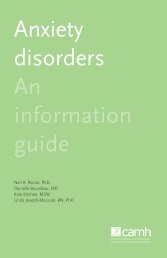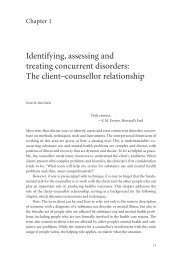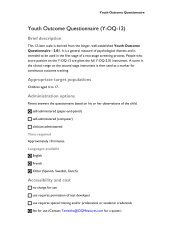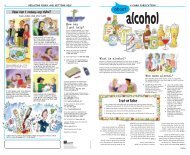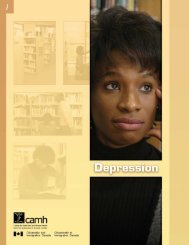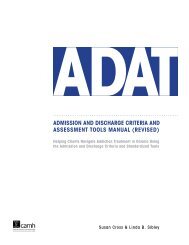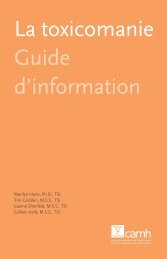A family guide to concurrent disorders - CAMH Knowledge Exchange
A family guide to concurrent disorders - CAMH Knowledge Exchange
A family guide to concurrent disorders - CAMH Knowledge Exchange
- No tags were found...
Create successful ePaper yourself
Turn your PDF publications into a flip-book with our unique Google optimized e-Paper software.
Introduction <strong>to</strong> Concurrent Disorderspeople with severe mental illness who also have substance use problems tend <strong>to</strong> experiencea wide range of serious problems. Common issues include:• more severe psychiatric symp<strong>to</strong>ms, such as depression and hallucinations• more dramatic effects after using substances, including more blackouts• a greater chance of not following treatment plans• physical health problems• increased experiences of stigma• financial problems• housing instability and homelessness• poorer management of personal affairs• serious relationship problems with <strong>family</strong> members• more verbal hostility, tendency <strong>to</strong> argue, disruptive behaviour, aggression• violence or crises that may end up involving the police• a greater likelihood of ending up in jail• increased suicidal feelings and behaviours.IMPACT ON THE FAMILYHaving <strong>concurrent</strong> <strong>disorders</strong> obviously affects the person experiencing the <strong>disorders</strong>directly, but they also have powerful effects on <strong>family</strong> members and friends. As problemsbecome more complex, <strong>family</strong> members are often confused about which problems arecauses, and which are results. They are often puzzled and frustrated if their relative continues<strong>to</strong> use alcohol or other drugs when the consequences are so severe. We discussthe impact on the <strong>family</strong> in Chapter 4 and talk about coping strategies in Chapter 5.AN INTRODUCTION TO TREATMENTDetecting substance use and mental health problemsBecause of the overlap of symp<strong>to</strong>ms between mental health and substance use <strong>disorders</strong>,it is often difficult <strong>to</strong> make a firm diagnosis in the early stages of treatment. For example,symp<strong>to</strong>ms resulting from in<strong>to</strong>xication and withdrawal can look a lot like symp<strong>to</strong>msof mood and anxiety <strong>disorders</strong>. A period of s<strong>to</strong>pping, or cutting down on, substance useis often necessary before therapists can say whether a client has a substance use problemor a mental health problem—or both.The best way <strong>to</strong> tell the difference between the symp<strong>to</strong>ms caused by substance-relatedand other mental health problems is <strong>to</strong> observe the person when no substances arebeing used. However, experts don’t agree on how long the person needs <strong>to</strong> s<strong>to</strong>p usingsubstances before a separate problem can be identified. Usually, the required period ofabstinence depends on the substances being used and the suspected mental healthproblem. For example, drugs that stay in the body for a long time (e.g., long-acting ben-8



